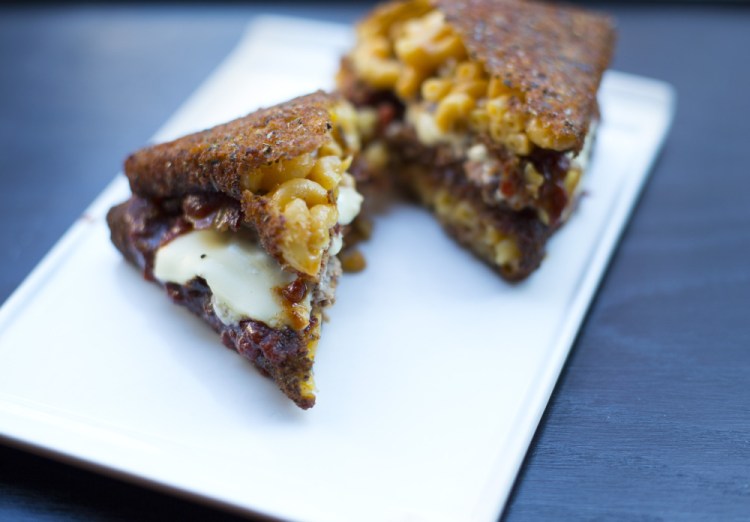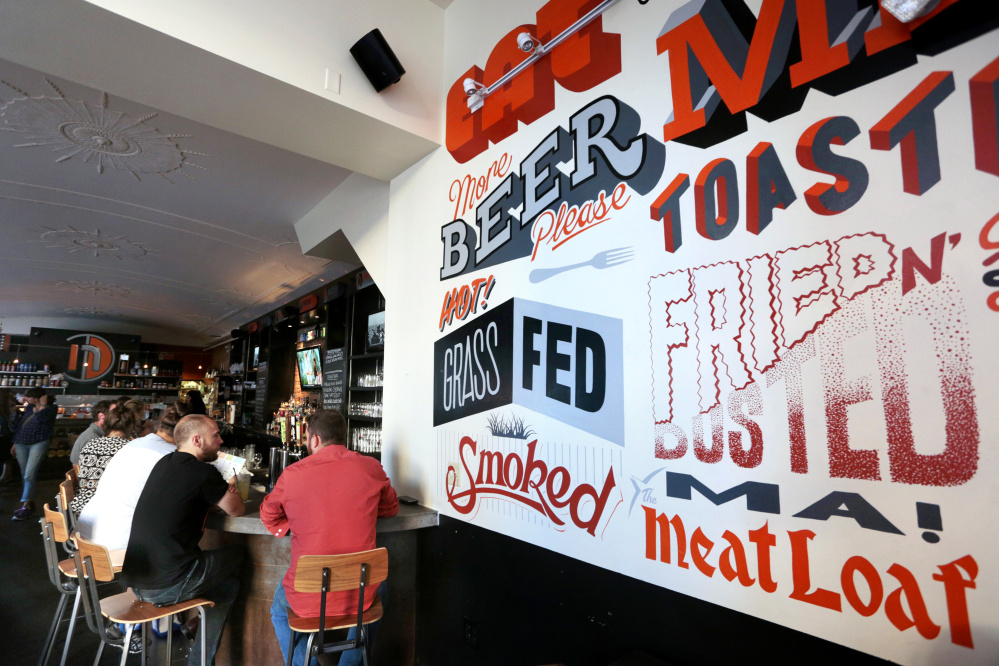Ask a group of New Yorkers or Yiddish speakers (or both) what they think of when they hear the word “nosh,” and you’ll get a surprisingly good consensus. Mostly, they’ll say the word describes snack food of some sort, almost never a full meal. As a verb, it describes an activity in the gray area between nibbling and casual grazing.
But you don’t have to know what the term means when you walk into Nosh, in Portland’s arts district, because the restaurant helps you out with a definition printed on the front door. It’s a good idea, even if it doesn’t prepare you for what you’ll encounter inside, in the arched dining room that still retains plaster work from its first incarnation as a movie theater. Incongruous with the delicate ceiling is a heavily branded bar with local beers on tap, along with three televisions (all tuned to different channels), high tables with elevated wooden banquette seating and a partly open kitchen that looks like a place where a DJ might spin the music that blares throughout the echoing space. Nosh is, in a word, loud.
But that fits with at least part of chef/owner Jason Loring’s vision for his restaurant. “Lots of the complaints we get are about the loudness. But boisterous is what we’re looking for,” he said. “We want it to be a place where if someone breaks a glass or smashes some plates, it’s not a big deal. You won’t even notice.”
High volume also seems to be a natural match for the menu’s overarching focus on high-concept extreme hamburgers, including one constructed from two thick slices of Sicilian pizza (from another Loring restaurant, Slab) and one that uses two entire doughnuts in place of a bun. Or the Nosh Mac ‘N Stack ($15), an American cheese-coated beef patty sandwiched between two leaden, deep-fried squares of compressed macaroni and cheese that look like and have the heft of paving tiles. We found the macaroni to be well-seasoned but very dry, a necessary concession to the process required to get it to retain its shape until it is served.
At the same time, the beef itself was outstanding, as it was in both the Nosh Burger ($12), a breakfast-style hamburger with blue cheese spread and a fried egg on top, and the classic (but still oversized) Cheese Burger ($10). Nosh’s executive chef Noah Leether has a real talent for keeping patties moist and just a little pink inside. Sadly, the impressive grill technique simply gets lost amid the attention-sucking spectacle of a monster truck of a burger.
Nosh wasn’t always like this. When it opened in 2010, the restaurant served what Loring describes as “lots of fish, pickled items, homemade charcuterie, vegetables … a couple of burgers too, but it was a lot like tapas,” a menu very much in tune with the name. Soon after, Loring saw an episode of “Man vs. Food” and thought it might be fun (and a good marketing strategy) to put what he describes as a “ridiculous” burger on the menu. With that, the practically libertine Apocalypse Now Burger ($21), a beef, pork belly, foie gras and bacon behemoth, was born. It wasn’t long before Nosh attracted attention for its towering hamburgers, including from the very television program that inspired the new sandwich.
It also wasn’t long before the equilibrium of the place shifted dramatically, away from vegetables and seafood, away from smorgasbord-style spreads of small items, evolving toward jumbo sandwiches with their own gravitational field, like the foot-long spicy shrimp po-boy ($14), which, stuffed mostly with shredded lettuce and topped with six tempura-battered (and soggy) shrimp, somehow manages to feel too large and stingy at the same time.
Even though the change in focus fit with Loring’s plan to run a casual, late-night eatery, he was a little discouraged by the rejection of his original offerings. “But I got a quick business education out of it: Sometimes customers don’t know they want something until you put it on the menu, and the restaurant just flowed in that direction,” he said. “I wasn’t going to fight it. Ultimately, I’m fine with it, but it took a little getting used to.”
A few reminders remain of what the old Nosh must have been, like snappy, sour Maitland Mountain Farms spicy pickles ($4) and a well-conceived, if not perfectly executed Mediterranean plate ($15) of mezze with nutty and slightly sweet falafel, tender and oniony Israeli couscous salad, alongside characterless pitted olives, bland hummus, and wedges of grilled naan that desperately needed another brush of oil.
There is a lot on the menu that also feels perfunctory, like the serviceable if undistinguished Reuben sandwich ($14), a tuna avocado toast ($13) made with tuna salad and Mexican cheese that tastes like a dry, open-face deli-style tuna melt, and both of the desserts we tasted when we visited. The Betty Ford Brownie Sundae ($8) was a mass grave of a dessert, where seemingly anything in the bakery from which Nosh outsources its sweets – from an Oreo and chocolate chip brownie, to vanilla ice cream, chocolate ganache, dulce de leche and peanuts – was squashed unceremoniously into a bowl and buried in whipped cream. On my next visit with two college-age friends, I tasted another slice of that same brownie (as well as the same ice cream and peanuts), this time folded inside in a “churro” taco ($9) that was really just a fried white flour tortilla sprinkled with cinnamon sugar.
Yet the menu has some bright spots. Some of the most successful post-evolution dishes balance greasy elements with brighter flavors, like wonderful sweet potato tater-tot “nachos” ($11) that feature garlic sour cream and marinara-like ranchero sauce, or the best dish I ate at Nosh: crisp, savory polenta fries ($12) made with cheddar cheese and topped with a fresh, green jalapeño sauce, arugula and slices of vividly spicy Fresno chilies. These still have all the appeal of bar food without the excess of a fat-upon-fat gut bomb.
After both visits to Nosh, I left puzzled about its intended audience. Surely anyone sensitive to noise won’t feel welcome, nor will anyone watching their LDL cholesterol (or waistline). My millennial friends enjoyed the vibrancy of the place, but commented that the appealing ideas often suffered from spotty execution. Another remarked that Nosh reminded her of somewhere she might have gone while in college.
And suddenly, I saw clearly what Nosh has become. Today, there is no salmon, no bagels, no whitefish, no black-and-white cookies, nothing with pastrami – very little that is traditionally “noshy.” What the restaurant does have instead is whopping portions of bar food, steroidal burgers with ludicrous buns, and a booming sound system – like a restaurant that could fit right in next-door to a big land-grant university, a place where overexcited undergrads go before a big fraternity party. These days, perhaps it should be called Rush rather than Nosh.
Andrew Ross has written about food in the United Kingdom and in New York, where he co-founded NYCnosh, a food website. He and his work have been featured on Martha Stewart Living Radio and in The New York Times. He is an internet researcher and higher education consultant. Contact him at andrewross.maine@gmail.com and on Twitter @AndrewRossME.
Send questions/comments to the editors.




Success. Please wait for the page to reload. If the page does not reload within 5 seconds, please refresh the page.
Enter your email and password to access comments.
Hi, to comment on stories you must . This profile is in addition to your subscription and website login.
Already have a commenting profile? .
Invalid username/password.
Please check your email to confirm and complete your registration.
Only subscribers are eligible to post comments. Please subscribe or login first for digital access. Here’s why.
Use the form below to reset your password. When you've submitted your account email, we will send an email with a reset code.